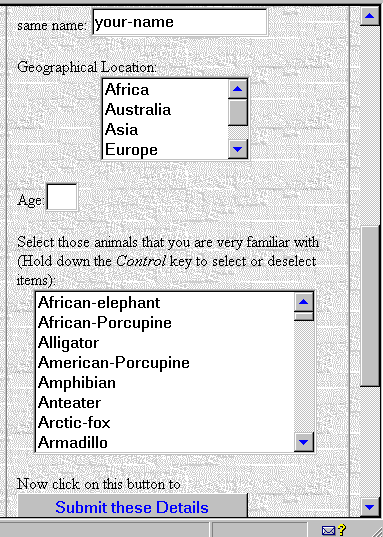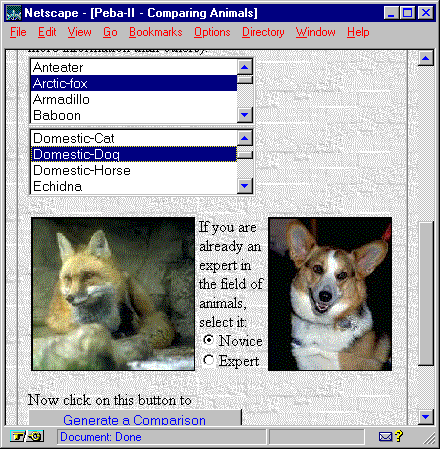"Giving the Web intelligence: the ability to "understand" the user, to customise information and presentation and to dynamically support navigation; may be the next significant leap from a popular medium to one which is a valuable teaching mechanism in its own right." Eklund & Zeiliger, (1996)
ADAPTIVE HYPERMEDIA
& ONLINE LEARNING
TRADITIONAL HYPERMEDIA SYSTEMS
The World Wide Web hypertext/media system allows the user to freely navigate between nodes by following links in an extensive, decentralized network of information and knowledge. The open, free-browsing nature of the web affords exploratory and inquiry-based learning with a high degree of student control. At the same time however, given the extensive growth of the World Wide Web, the potential is great for user disorientation in such a large knowledge base. A further problem with hypermedia navigation is that it is not specifically designed to differentiate between and to accomodate users with different interests, goals and needs. Thus, traditional hypermedia systems present a disadvantage for educational use of the World Wide Web since without direct teacher or system support, students' learning experiences may not be very efficient or effective. While a discovery or inquiry-based type of online learning may be envisioned as an effective model, it nonetheless needs to be coupled with some type of system control or support.
ADAPTIVE HYPERMEDIA SYSTEMS
Adaptive hypermedia systems are presently being designed and developed in recognition of the need to provide some system support and control to users. An adaptive hypermedia system aims to provide a solution to the problem of disorientation and the need to accommodate varied users by being capable of searching for and filtering out the information most relevant to the user's needs, goals and interests.
Adaptive systems can incorporate domain knowledge (for example about a particular subject area such as mathematics) and knowledge about its users. An adaptive system might provide a different body of information, or a different level of abstraction or treatment based on characteristics such as user's age, language, geographical location or on whether the user is a novice or expert. Thus, such a system attempts to tailor its reponse to the user's needs.
"By adaptive hypermedia systems we mean all hypertext and hypermedia systems which reflect some features of the user in the user model and apply this
model to adapt various visible aspects of the system to the user." Brusilovsky quoted from comments made to the Adaptive Hypermedia & Hypertext Mailing List, 1997.

"If you would like the system to remember who
you are and to tailor descriptions to your knowledge, then you
might like to set up a user profile before beginning."Peba-II
"Because Peba-II produces descriptions as you ask for them, it can modify what it tells
you based on what it thinks you already know. You can inform the system of your existing
knowledge by filling in the user profile below. At this stage your age and geography don't
affect the text, but we will be implementing that fairly soon." Peba-II
PEBA-II: AN ADAPTIVE HYPERTEXT SYSTEM
The Peba-II Text Generation System uses a natural language generation system to dynamically and interactively produce hypertext descriptions of animals in the form of World Wide Web pages. Peba-II uses a taxonomic knowledge
base to produce
descriptions of animals that vary depending on whether the user is a novice or expert. Future versions of such systems might provide descriptions based on other characteristics such as age or previous interactions with the system or the domain knowledge.
"Peba-II is a natural language generation system which dynamically
produces hypertext descriptions of animals. The descriptions of
animals that you see do not already exist on the computer like normal
World Wide Web (WWW) pages. Instead, Peba-II dynamically creates
them as you ask for them." Peba-II
AN ADAPTIVE ELECTRONIC TEXTBOOK
An example of an adaptive system which provides navigational support is InterBook which is a tool for both authoring and delivering adaptive electronic textbooks on the World Wide Web. Users register with the system and based on this registration and on the user's session, the InterBook server builds and stores a model of the user's knowledge which it then uses to sequence material, provide
guidance, navigation support, and adaptive help.
The system consists of both a domain model and a user model which is based on an estimation of the user's knowledge level. Also included is a glossary which can provide a description of a concept and
links to all book sections which introduce the concept. A built-in indexing component allows the system to know which concepts are present on each page and which concepts must be acquired before the learner begins a new page. Links to all textbook units on a particular concept are dynamically generated to reflect the user's current state of knowledge of the concept. A further interactive component of Interbook is its use of icons, fonts, and colours to distinguish , for example, whether the page is ready to be learned, or whether some
prerequisite knowledge is first required. This information is dynamically generated on the basis of the
user model.

"Interbook is an adaptive system. It maintains a model of your knowledge on the subject and uses it to provide you with adaptive navigation support and intelligent help. The model is stored on the server between sessions."Interbook
"Adaptive hypermedia lies midway along the
continuum of the locus of control between completely user-controlled
hypermedia environments like the WWW at large, which represent an
implementation of the contructivist ideal, and the other end of the
continuum which is represented by the regimented programmed learning
environments typical of intelligent systems, following a behaviourist
approach." John Eklund in e-mail correspondence.
FUTURE PROSPECTS FOR ADAPTIVE HYPERMEDIA
Adaptive hypermedia represents a relatively new area of research. A limited number of models or systems have actually been implemented particularly in the case of users of school age. Current systems provide for user-modelling at a very basic level. Furthermore, while systems do incorporate domain and user models, they do not, as yet, include pedagogical knowledge. The potential of adaptive hypertext and hypermedia for teaching and learning has thus yet to be realized. At the same time, the notion of an adaptive system modelled on individual users or even on a class of users makes future exploitaion of the web for educational purposes look very promising. Such a system could provide much needed support for an exploratory or inquiry style of learning. It could also provide for a choice of learning styles in a continuum ranging from strongly system controlled or supported to student controlled, or from instructionist to constructivist.
FURTHER READING
©1997, Elizabeth Murphy, St. John's, Newfoundland, Canada. Thanks to John Eklund from The University of Technology, Sydney, Australia who read and revised a first draft of this document & who answered many questions via e-mail & to Dale Fraser of Stemnet who provided valuable technical assistance. This page was designed to be viewed at a resolution of 640 x 480. Your comments are welcome!
|


